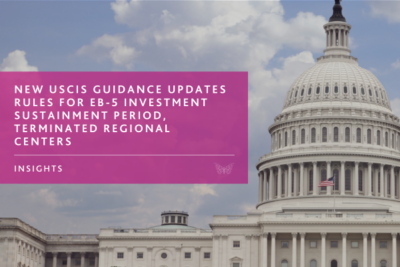Part 3 of 5 in the EB-5 Economic Impact Webinar Series
While the EB-5 Immigrant Investor Program has long been known for financing major urban development projects, its most transformative effects may be just beginning to take shape—in rural America.
In Part 3 of our blog series on the 2025 IIUSA Economic Impact Study webinar, we take a closer look at how EB-5 is helping to bridge the economic divide by funding critical infrastructure in underserved areas, supporting workforce training, and driving long-term rural growth.
A Post-RIA Shift Toward Rural Investment
The EB-5 Reform and Integrity Act of 2022 (RIA) introduced reserved visa categories for rural projects—a move that’s already shifting the geographic distribution of EB-5 capital. As CanAm COO Christine Chen noted during the webinar, “The congressional goal of the RIA was to redirect investment into areas that historically hadn’t seen a lot of EB-5. We’re absolutely seeing that happen now.”
This shift isn’t just symbolic. It’s meaningful. The same economic impact study that analyzed EB-5 activity between 2016 and 2019 found that each investor generated 45 American jobs—well beyond the program’s 10-job requirement. Now, as that investment migrates to rural regions, those jobs are making a tangible difference where they’re needed most.
Creating Jobs—and Talent Pipelines
One of the biggest challenges in rural economic development is ensuring that there’s a local workforce ready to fill the jobs created. EB-5 projects are addressing this head-on.
“We’ve seen companies partner with local colleges to build workforce training programs tailored to EB-5-supported projects,” Chen said. “That might not have happened without the capital and long-term commitment EB-5 brings.”
She cited examples such as broadband infrastructure initiatives, where EB-5 investment is supporting both physical network development and the human capital needed to maintain it. “To be economically competitive—even small towns need connectivity,” she said. “That requires skilled workers, and EB-5 is helping build that pipeline.”
The Ripple Effect: How EB-5 Spurs Broader Rural Development
EB-5’s impact in rural areas doesn’t stop at the job site.
“These are not just construction jobs,” said Ed Smith of JTC. “They lead to permanent employment, business growth, and new economic activity—from restaurants and retail to hospitality and housing.”
Smith also pointed to the broader concept of economic mobility—the idea that jobs created through EB-5 in rural areas can offer more than a paycheck. “You’re seeing jobs that people can grow into—jobs with upward mobility and skills development. That’s how you keep talent in rural communities and fight brain drain.”
A Real-World Case Study: The Philadelphia Shipyard
While not rural, one EB-5-funded project highlighted during the webinar exemplifies the program’s potential to support workforce innovation. CanAm Enterprises helped finance the Aker Philadelphia Shipyard—a venture aimed at reviving U.S. shipbuilding by leveraging a former naval yard.
“The project included housing and training for workers,” said Chen. “The workforce simply didn’t exist at the time, so EB-5 capital enabled the creation of something entirely new—an entire skilled labor force for a critical industry.”
That same kind of impact is now being replicated in rural regions across the U.S., especially where infrastructure, education, and housing are being developed simultaneously with job creation.
Rural EB-5: Small Markets, Big Potential
The study’s findings underscore that EB-5 can be more than just a project-level financing tool—it can be a community-building tool.
Christine Chen put it best:
“In some rural areas, the downstream impacts are even greater because you’re not just supporting existing businesses—you’re helping create entirely new ones.”
That includes grocery stores, transportation networks, and even schools—local institutions that are essential to long-term economic sustainability.
What’s Next: Data to Drive Policy
Looking ahead, the IIUSA panelists emphasized the importance of continuing to collect data on rural EB-5 investment in the post-RIA environment. With so much activity shifting to underserved regions, the next impact study may reveal even more dramatic results.
“I hope we get to do a post-RIA version of this economic impact study,” said Chen. “We’ll likely see some incredibly powerful patterns that speak to EB-5’s value in rural America.”
Read the full economic impact study
Download the one-page summary
Stay tuned for Part 4 of our series, where we’ll spotlight the contributions of EB-5 immigrant investors themselves—and the often-overlooked revenue they generate for local, state, and federal governments.








